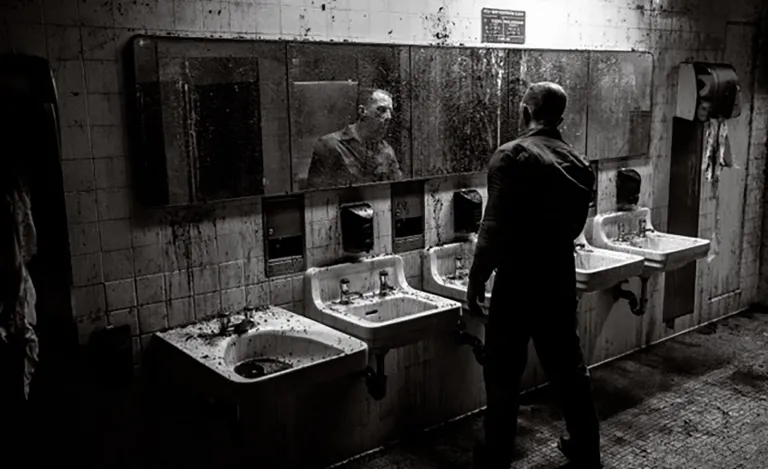
[This is the fourth in a series of posts on the filming of Nightmare Cinema’s “This Way to Egress.” The film is available to stream on Freevee and Tubi or to rent/own on Amazon, Apple, and Vudu.]
Seven years ago this month, the crew of “This Way to Egress” transformed the restroom of a downtown LA office building to create the scene depicted in the above photo. In this post, I’d like to share a few thoughts about that scene.
But first, some context.
Midway through Ruben Östlund’s film Triangle of Sadness, there’s a show-stopping sequence in which (as summarized in a New Yorker review) “the toilets on [a luxury] yacht overflow, sending rivers of runny excrement coursing through the hallways and down the boat’s steps, drenching the passengers.”
If you’ve seen the film, you know the moment. How could you forget? And yet, such toilet mayhem is nothing new, especially in horror literature—a genre that often seeks to (excuse the pun) plumb the hierarchy of fear (which Stephen King identifies as consisting of terror, horror, and gross-out).
As such, Triangle’s erupting commodes have a precedent that goes back at least as far as the 14th century, when Roman poet Virgil led political exile Dante Alighieri through a region of hell called Malebolge (the evil trenches). There, from the relative safety of a high bridge, the poets “saw long lines of people in a river of excrement that seemed the overflow of the world’s latrines.”

The scene is literally something out of a nightmare, at least according to Michael Schredle of the Central Institute of Mental Health in Mannheim, Germany. In his article “Toilet Dreams,” published in the International Journal of Dream Research, Dr. Schredl contends that nightmares involving toilets “have been reported as a common dream theme for centuries,” and that most of them involved finding oneself in an “unfamiliar and often public setting” and confronting “toilets that are constructed in unusual or even bizarre ways.”
Interestingly, I can’t think of a novel or film that features a monster toilet. There are, however, numerous examples of monsters in toilets (Ghoulies) and plenty more instances of people diving into them. Consider, for example, a show-stopping scene from Danny Boyle’s Trainspotting (1996), in which Renton (Ewan McGregor) plunges into the backed-up bowl of “the worst toilet in Scottland” to retrieve a packet of heroin (a desperate dive that recalls a similar one from Thomas Pynchon’s 1973 novel Gravity’s Rainbow, where Tyrone Slothtrop goes after a lost harmonica.) More toilet diving (this time for hacksaw blades) takes place in James Wan’s Saw (2004), where two victims find themselves chained to the plumbing of a foul restroom.

And then there’s the scene from “Egress,” where Helen is compelled to enter a men’s room in an effort to locate her lost sons.
As mentioned in this blog’s previous posts (“Grit” and “Heft and Presence“), Director David Slade was determined to film “Egress” in actual locations, convinced that doing so would lend the weight of reality to the increasingly surreal set pieces. And so it fell to Production Designer Lauren Fitzsimmons, Property Master Leone Reeves, and their dedicated crew to completely transform a functioning men’s room in a downtown office building.
But whereas most of the other locations had been spattered with black grit and slime, this set was dressed with red gore. An interesting choice given that “Egress” was shot entirely in black-and-white. Nevertheless, watching this scene, one senses the hues of violence. As a reviewer in Slant Magazine insightfully pointed out, the scene conveys “a setting of apparent mass murder.”

Upon entering the room, Helen finds a janitor (Ezra Buzzington) working at a line of sinks. First seen from behind, then reflected in a filthy mirror as he plunges a clogged drain, the janitor seems more intent on pulling gore out of the pipes and into the restroom than he is concerned with opening the drains. The result is a line of blood-smeared sinks, as if all the sewers of a wounded city have hemorrhaged into that tight, windowless space.
The scene conveys the troubled state of Helen’s mind. And that, as near as I can remember, was my intention when I wrote the original story (“Traumatic Descent”) back in the early 1990s, well before Trainspotting, Saw, or Triangle of Sadness. Not that I intend to claim the men’s-room scene in “Traumatic Descent” inspired the toilet nightmares in any of those films. Nor do I mean to suggest I was consciously alluding to Canto XVIII of Dante’s Inferno. Like him, I was merely tapping into what Michael Schredle tells us has long been the stuff of nightmares.
Next time, we’ll take a look at the monsters of Egress, the practical and digital effects that transformed them, and the skilled actors who brought them to life.
Until then, keep plunging.


Leave a Reply